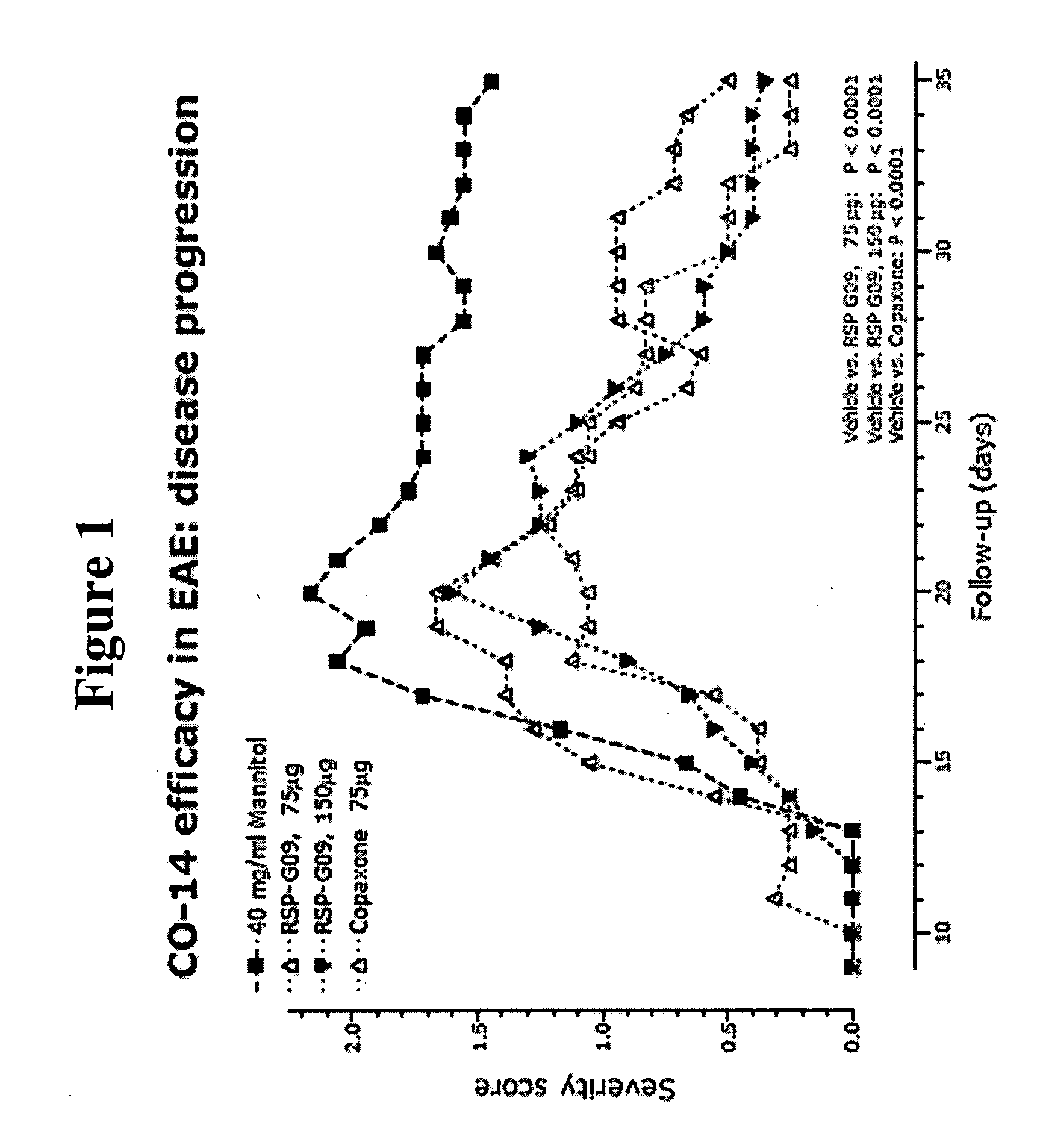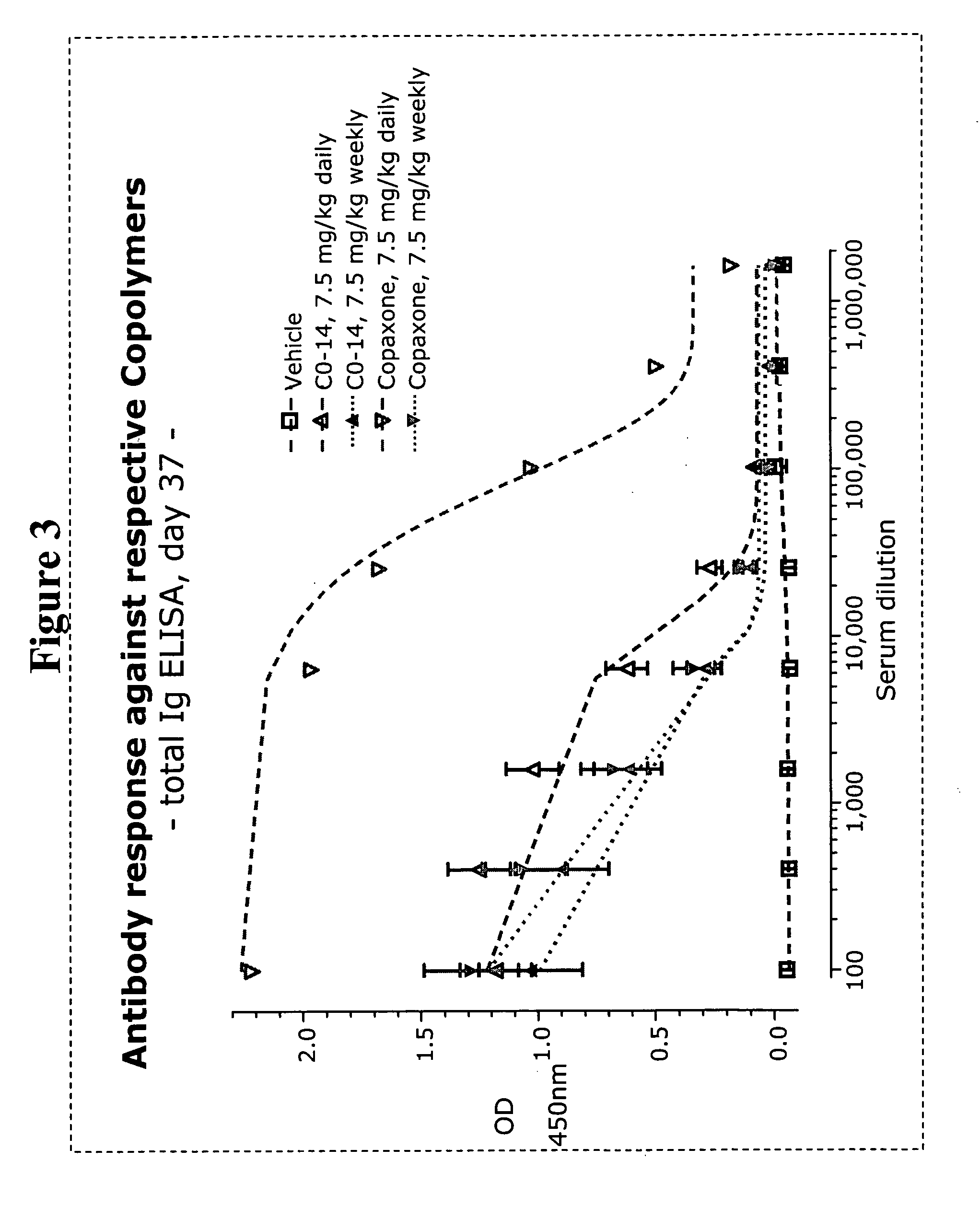Methods of treating disease with random copolymers
a random copolymer and disease technology, applied in the field of random copolymer treatment, can solve the problems of increasing the likelihood of the broadening of the offending epitope, affecting the treatment effect, so as to improve the effect of cop 1, and improve the effect of cop
- Summary
- Abstract
- Description
- Claims
- Application Information
AI Technical Summary
Benefits of technology
Problems solved by technology
Method used
Image
Examples
example 2
T Cell Response to Random Copolymers
[0242] The TH1 and TH2 profiles of mice injected with 5 μg Copaxone™ or Co-14 (YFAK) three times a week or on weekly bases, up to day 22 of the treatment. On day 2, 8, 9, 15, 16, 22, 23, 29, spleens were collected and splenocytes were isolated. 400,000 cells per well of splenocytes were restimulated with various concentrations (0.8, 4, or 20 μg / ml) of Co-14 (YFAK) for three days. On day 3 of the cell culture, the cells were transferred onto ELISPOT (enzyme-linked immunospot assay) plates, coated with either IFN-γ (interferon gamma) or IL-13 (interleukin 13). The T cell response is examined by measuring the IFNγ production (a TH1 cytokine) and IL-13 production (a TH2 cytokine). The degree of T cell stimulation is also examined by measuring the proliferation of the cells shown as tritiated thymidine intake.
[0243] A burst of response was seen in the first week of dosing, followed by a decreased but sustained response. As seen in FIG. 9, the respons...
example 3
Generation of Peripheral Responses to YFAK in Non-Human Primates
[0244] Twelve adult macaca fascicularis / cynomolgus monkeys, weighing at 2-5 kg, were administered Co-14 (YFAK) daily for fourteen days, at the dosage of 0 mg / kg, 0.2 mg / kg, 2 mg / kg, or 40 mg / kg Co-14 (YFAK) subcutaneously. Blood was drawn on days 0, 1, 8, 15, 28, and 35 into lithium heparin tubes. Red blood cells were removed using Ficoll® gradient centrifugation, and plated in round bottom 96 well plates in growth medium containing 5% serum. The cells were plated at 400,000 / well. Co-14 was added to the medium on the first day of culture at concentrations ranging from 0.2 ug / ml to 100 ug / ml. For proliferative analysis, tritium was added to the medium on day 3, and cells were harvested the next day. For flow cytometric analysis, cell were harvested on day 3 and stained with fluorescently labeled antibodies. Serum samples were taken on day 35 and used to measure anti-Co-14 antibodies (IgG). The activation of T regulatory...
example 4
Generation of T-Cell Responses to Co-14 with or without E. Coli Heat-Labile Enterotoxin (LT) Delivered by Transcutaneous Injection (TCI) or via Subcutaneous Injection of Co-14 in Water
[0246] Female C57BL / 6 and SJL / J mice were immunized in the following manner. Twenty-four hour before immunization, the dorsal caudal surface will be shaved to remove hair. Immediately prior to immunization, the bare skin will be briefly hydrated with 10% glycerol in saline. The exposed skin will be mildly treated with emery paper (10 strokes) to disrupt the stratum corneum. Animals were immunized either transcutaneous on day 1 and 15 with Nu-gauze patch containing Co-14 (50 or 100 ug) alone or mixed with 10 μg LT, or a parenteral injection on day 1 and 15 with a topical LT IS-patch. Co-14 was intradermally injected into the pretreated skin; a 1-cm2 gauze patch affixed to an adhesive backing was loaded with 10 μg LT or PBS (no LT) and applied directly over the site of injection. A final group was sensi...
PUM
| Property | Measurement | Unit |
|---|---|---|
| Time | aaaaa | aaaaa |
| Length | aaaaa | aaaaa |
Abstract
Description
Claims
Application Information
 Login to View More
Login to View More - R&D
- Intellectual Property
- Life Sciences
- Materials
- Tech Scout
- Unparalleled Data Quality
- Higher Quality Content
- 60% Fewer Hallucinations
Browse by: Latest US Patents, China's latest patents, Technical Efficacy Thesaurus, Application Domain, Technology Topic, Popular Technical Reports.
© 2025 PatSnap. All rights reserved.Legal|Privacy policy|Modern Slavery Act Transparency Statement|Sitemap|About US| Contact US: help@patsnap.com



